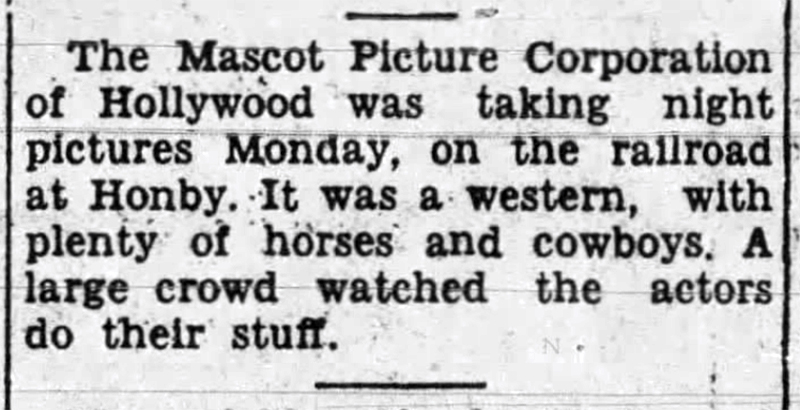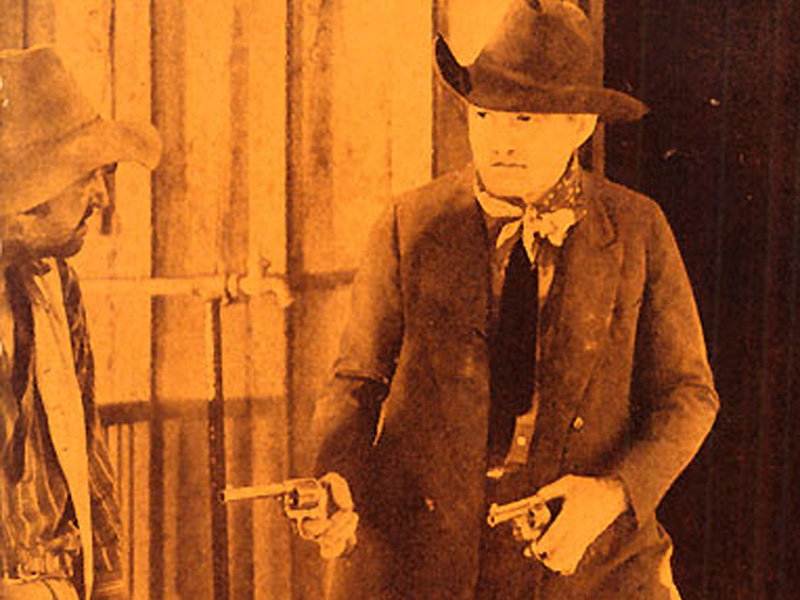|
|

|
Beale's Cut is used in two "jump" sequences in the 12-chapter Paul Malvern/Mascot Pictures serial, "The Devil Horse" (1932), starring Harry Carey. They are shown here back-to-back. The first features 14-year-old Frankie Darrow. The line is, "Only a devil horse could have made that jump." Actually, only a winged horse could have made that mid-air course correction. It's movie magic. In the second sequence, Carey is supposed to be carrying Darrow on horseback as he makes the jump. We show it twice, once at regular speed. Then we slow it down to focus on a few things, starting with a peculiar wooden structure that Yakima Canutt (doubling for Carey) rides over while clutching a sack stuffed with something-or-other to represent Darrow. The wooden structure seems to be designed to trip Canutt's horse so it falls forward, off-screen and into what would be the trajectory of the cut. Then comes the animation. We stop on a frame with two lines, or blobs, projecting from a horse's back to represent two riders. Then we see an especially elastic "horse" stretch to nearly the full width of the cut. What happens next is anyone's guess. Often a production crew would toss a large sack off of a cliff to represent a horse fall. In this case, the "horse" falls backward and then miraculously rights itself to fall feet-first into a lake. Who knew there was a lake at the bottom of Beale's Cut? Of course, if a horse or rider ever were to fall from that point of Beale's Cut, 8 to 9 stories off the dry ground, they'd be dead. The scenes were probably effected by splicing an actual horse run across the top sides of Beale's Cut, with frame-by-frame editing in between. The parts that are "real" are the establishing shots of Beale's Cut and maybe the tossing of a fake horse and riders over the side. If Canutt, who designed all of the "horse work" in the picture, had designed an actual jump over the cut, he would have mentioned it in his discussion of "The Devil Horse" in his autobiography. He didn't. Video courtesy of Stan Walker.
Saugus rancher and A-list actor Harry Carey Sr. cuts a fatherly figure in his third and final 12-chapter serial for Mascot Pictures, "The Devil Horse" (1932). (The others were "The Vanishing Legion" and "The Last of the Mohicans.") "The Devil Horse" is an expansion of the 1926 Hal Roach picture of the same name. Both pictures featured the stunt work of Yakima Canutt and a wild horse. They even used some of the same film footage, and the 1932 version matched locations in the Newhall area for continuity. Producer Nat Levine wanted Rex the Wonder Horse to reprise his 1926 role, but by now Rex was a big-money star. Carey was costing him $10,000, Noah Beery wasn't cheap, co-star Frankie Darrow cost $3,000, Canutt $1,000, and Levine could afford only so many stars. He had budgeted $60,000 for the entire production and needed to pinch pennies if he was going to ramp it up and turn out five serials in 1933. So Levine cut corners. The unknown Greta Granstedt replaced Edwina Booth as the female lead, 12 chapters turned into nine full-action episodes and three cheaters, and Levine found new blood in a stallion named Apache. One trouble: Apache wasn't a trained movie horse. He lived up to his character's name, El Diablo, and put Canutt in the hospital. Canutt recalls a harrowing sequence in his 1980 autobiography:
I remember when Otto Brower was directing "The Devil Horse" in 1932. Harry Carey was doing the lead and I was doubling him in all his stunts. I had written a real hazardous ending for the first episode, but with the understanding that we would shoot it on the last day of the picture. This would give me the benefit of fulfilling my contract, whereas if we were to shoot it first and I got hurt, I'd lose my contract money. This stunt was rough. In a sequence with a wild stallion that Harry Carey was trying to capture, his horse falls and the wild stallion attacks him. He grabs the stallion by the ears with one hand and swings his body under the animal's neck, straddling the neck in an upside-down position, and locking his spurs on top of the horse's withers. We used a trained horse for the first part of the scene where he charges Carey. After Carey got hold of the trained horse's ears, I took over. Then we substituted the trained horse with a real rodeo bronc that was full of fight. I rigged a strong strap around the horse's neck so that I could hang on at either ear. Then, with three cameras set and ready to shoot, we put a blindfold over the bronc's eyes and got him quieted down with the help of a couple of cowboys. I got a good hold of the strap and ears and, as the cameras started turning, the two helpers eased off the blindfold and dashed out of the scene. The horse stood for a second or two, then, as he started to rear, I swung my body under his neck and hooked my spurs over the top of his withers. He reared high and spun around trying to strike me with his front hooves but, because of the position I was in, he could only hit me with the forward part of his front legs. Those spurs tickling his withers sure set him in motion — he practically exploded, rearing, spinning and doing everything he could to shake me loose. I was able to hang on, but with my two hundred pounds hanging on his head, he was thrown off balance and he finally fell hard to the ground. The next thing I knew, bells were ringing, birds were singing, and I could barely make out a couple of cowboys who seemed to be trying to help me. I dazedly asked them what had happened and one of them said that the bronc turned a somersault and lit on top of me. I felt as if an Indian war party had just finished a dance on my chest. One of the men drove me to the hospital in Hollywood, and then went to the studio to report... Canutt actually played two completely different roles in "The Devil Horse." It didn't seem to bother audiences, who generally had to wait a week between chapters.
The Mascot book (Tuska 1982) refers to the Newhall location as "the Prudential lot outside Newhall." We don't know where that was. It might have been a lease near the contemporaneous Trem Carr and Andy Jauregui movie ranches in Placerita Canyon (later site of Disney's Golden Oak Ranch), although a report in The Newhall Signal newspaper from that same year puts a Mascot production crew "with plenty of horses and cowboys" at Honby (which is closer to Saugus than it is to Newhall). The serial also used Beale's Cut, as well as the Iverson Ranch (Chatsworth), Kernville, Big Bear Lake and the Phoenix area. Richard Talmadge, Ken Cooper and the ubiquitous Cliff Lyons joined Canutt on the stunt payroll. The rest of the credited cast includes Barrie O'Daniels, Edward Peil Sr., Jack Mower, Al Bridge, Jack Byron, John Paul Jones, Carl R. Botefuhr and Lew Kelly. Uncredited cast members are Canutt, Lyons, Victor Adamson, Lionel Backus, Lane Chandler, Ken Cooper, Kernan Cripps, Gordon De Main, Dick Dickinson, Jack A. Goodrich, Dannie Mac Grant, Henry Hall, Tracy Layne, Wilfred Lucas, Charles Schaeffer, Barry Shipman, Al Taylor, Robert Walker and Wes Warner.
|
FULL MOVIE:
Broken Ways 1913
FULL MOVIE 1938
Fan Reply Card <1928
Marriages
Marked Men 1919
A Fight for Love 1919
Harry & Olive 1919
Overland Red 1920
Canyon of the Fools 1923
The Seventh Bandit 1926 (Mult.)
Satan Town 1926
Burning Bridges 1928
Trader Horn 1931
The Vanishing Legion 1931 (Mult.)
The Devil Horse 1932
Rustler's Paradise 1935
Last of the Clintons 1935
Port of Missing Girls 1938
With U.S. VP John Garner 1940
The Shepherd of the Hills 1941 (Mult.)
Hollywood Walk of Fame
Nat Levine 1988
|
The site owner makes no assertions as to ownership of any original copyrights to digitized images. However, these images are intended for Personal or Research use only. Any other kind of use, including but not limited to commercial or scholarly publication in any medium or format, public exhibition, or use online or in a web site, may be subject to additional restrictions including but not limited to the copyrights held by parties other than the site owner. USERS ARE SOLELY RESPONSIBLE for determining the existence of such rights and for obtaining any permissions and/or paying associated fees necessary for the proposed use.


























